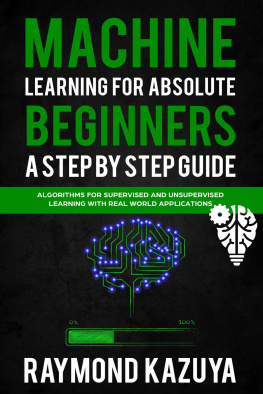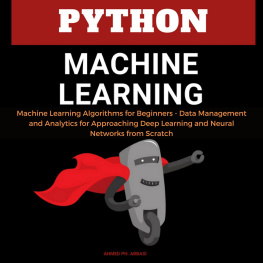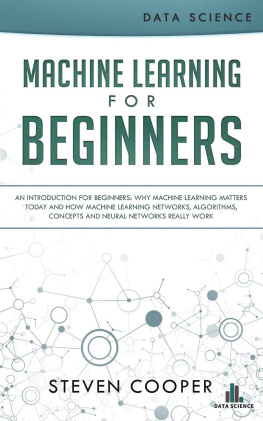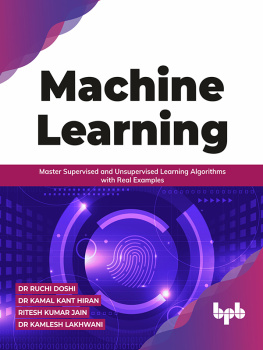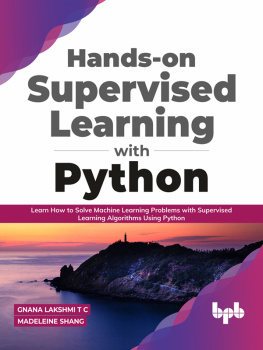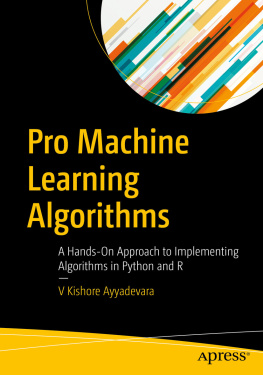Machine Learning For Absolute Beginners A Step by Step guide
Algorithms For Supervised and Unsupervised Learning With Real World Applications
Introduction
Chapter One: What is Machine Learning?
Subjects involved in machine learning
Chapter Two: Uses of Machine Learning
Density Estimation
Latent Variables
Reduction of Dimensionality
Visualization
Varieties of Machine Learning
Chapter Three: Common Machine Learning Terms
Classification
Regression
Decision Trees
Clustering
Support Vector Machines
Deep Learning
Neural Networks
Generative Model
Chapter Four: Supervised Machine Learning
Overview
Issues to consider in Supervised Learning
Other factors to consider
Chapter Five: Unsupervised Machine Learning
Chapter Six: Reinforcement Learning
Applications of Reinforcement Learning
Chapter Seven: Machine Learning Algorithms
K Nearest Neighbors
Nave Bayes Estimation and Bayesian Networks
Regression Modeling
Support Vector Machine
Decision Trees
Genetic Algorithms
Conclusion
Healthy Pragmatic Solutions Inc. Copyright 2017 - All rights reserved.
The contents of this book may not be reproduced, duplicated or transmitted without direct written permission from the author.
Under no circumstances will any legal responsibility or blame be held against the publisher for any reparation, damages, or monetary loss due to the information herein, either directly or indirectly.
Legal Notice:
You cannot amend, distribute, sell, use, quote or paraphrase any part or the content within this book without the consent of the author.
Disclaimer Notice:
Please note the information contained within this document is for educational and entertainment purposes only. No warranties of any kind are expressed or implied. Readers acknowledge that the author is not engaging in the rendering of legal, financial, medical or professional advice. Please consult a licensed professional before attempting any techniques outlined in this book.
By reading this document, the reader agrees that under no circumstances are is the author responsible for any losses, direct or indirect, which are incurred as a result of the use of information contained within this document, including, but not limited to, errors, omissions, or inaccuracies.
I want to thank you for choosing this book, Machine Learning For Absolute Beginners A Step by Step guide
Machines have come a long way since the Industrial Revolution. Every house, office and factory has some machines, but it is only in recent times that we have tried to estimate the capabilities of machines and how they can be used as substitutes for manual tasks. The scope of work for machines has extended to tasks that involve simulating cognition. These tasks could be performed only by human beings until recently. Judging competitions, beating professional chess players and driving cars are some of the few tasks that machines can now perform.
Some of the capabilities of machines have begun to instill fear in some observers. Most of the fear nestles on the insecurities that human beings have about survival, and it is this fear that gives rise to the what if questions.
What if machines decided they were superior to human beings and decided to fight us?
What if they developed the functionality to procreate and produce offspring with outstanding capabilities?
What if the myth surrounding singularity is true?
The other fear that most human beings have is the threat that machines pose to job security. According to BBCs interactive online survey, Will a robot take my job? job titles like waiters/waitresses, chartered accountants, taxi drivers, bar workers and receptionists will become automated by the year 2040.
Research studies on job automation should always be read with some skepticism since the future of artificial intelligence and machine learning is unknown. Technology is moving fast, but its adoption is an unchartered path with unforeseen challenges. Machine learning is not a simple task since it does not involve turning the switches on an off. It cannot be considered an out-of-the-box solution either. Machines operate in parallel to statistical algorithms, which machine learning engineers and data scientists often oversee. There is a belief that there will come a time when there will be an inadequate supple of human beings to operate and work with machines.
Your journey to becoming an expert in machine learning starts from here. If you are not looking at becoming an expert, you can use this book to understand the basics of machine learning. You do not have to decide now. Let us assume that you do want to become a data scientist or a machine-learning engineer. This book will help you achieve either goal.
This book covers all the information about machine learning that one would need to gather. The first section of the book covers machine learning and the different subjects that it comprises. This section also covers the different types of machine learning. The latter part of the book deals with the different algorithms that each type of machine learning entails. These algorithms are the ones that are used most often in computing.
Thank you for purchasing the book. I hope you gather all the information you were looking for.
Chapter One: What is Machine Learning?
L earning is not an easy word to define since it includes various processes. If you picked up the dictionary and looked for the meaning of learning, you would come across phrases like, "modification of a behavioral tendency by experience," and "to gain knowledge, or understanding of, or skill in, by study, instruction, or experience. This book will take a look at the different processes of machine learning in a way that is similar to how psychologists study learning in human beings. The spheres of machine learning and animal learning are interlinked. Some techniques used in machine learning are often derived from techniques used in human learning. Some breakthroughs in machine learning can bring to light some facets of human or biological learning.
When looked at from a higher level, it can be stated that a change made to the structure of a machine, concerning changes in the memory or composition, to enhance the performance of the machine, is a sign of learning in a machine. When machine learning is studied at a deeper level, only some changes made to the structure are considered as learning for a machine. For instance, consider a machine that is meant to predict weather forecasts in a certain area for a few weeks. The system is fed with information on the weather over the past year. The system uses this information to predict the data accurately for that city or state. This is an instance of machine learning.
Next page
